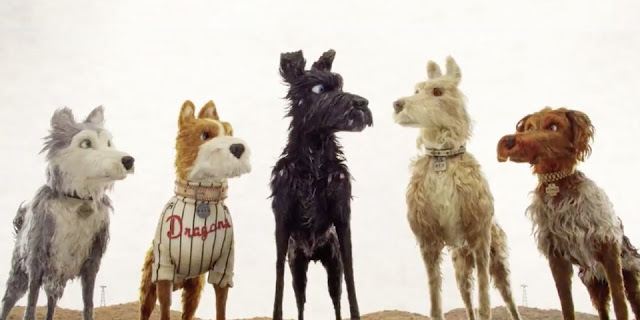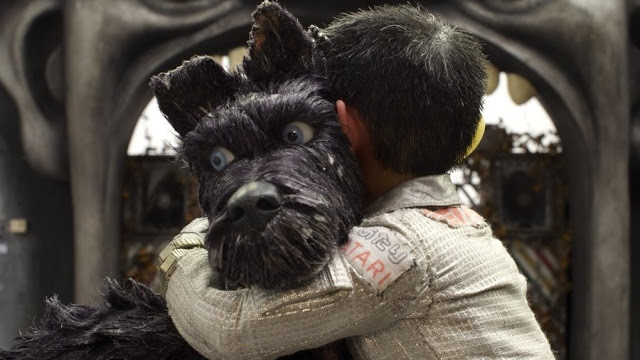In Wes Anderson’s Isle of Dogs, a corrupt and bigoted politician mongers fear to stigmatize a vulnerable class of citizenry, which he then unilaterally deports to a faraway land for the supposed safety of his voter base, despite scientific data demonstrating that this marginalized sect poses no threat to the populace. Also, there are talking dogs.
Anderson’s films are typically too micro-focused to toy with big-picture ideas, but this isn’t the first time he’s dabbled in political allegory; his last movie, The Grand Budapest Hotel, smuggled a poignant anti-fascist message inside its candy-colored packaging. The politics in Isle of Dogs are more pointed, the parallels to contemporary figures more easily drawn. But it would be a mistake to reduce this whimsical, stupendously well-made film to its symbolic elements. Anderson’s themes may be partisan, but his exquisite craftsmanship knows no ideology, except maybe perfection.
And from a pure technical standpoint, Isle of Dogs is pretty much perfect. It’s Anderson’s second feature that uses stop-motion animation, following Fantastic Mr. Fox. In a sense, though, every Wes Anderson movie is painstakingly animated, given the fastidious control he exercises over his productions. That fussiness can sometimes drain the humanity from his live-action films, which can feel overworked to the point of exhaustion. But the inherent artificiality of stop-motion—the labored movements, the punctilious creature and set design—paradoxically helps Isle of Dogs spring to more vibrant life. Rather than appearing needlessly quirky or obsessional, Anderson’s exactitude is inviting, pulling you in to his meticulously constructed fantasia.
If anything, “meticulously constructed” may be underselling it. Every shot in Isle of Dogs seems to have been composed with mathematical precision, with symmetrical framing that often places one character in the dead center, surrounded on each side by two other figures equidistantly spaced across the screen. Whenever the camera moves, it does so with lasered purpose, and always in a single direction; it pans left or right, or it zooms in and out, but it never does both at once, and it never travels at an angle. This gives the image an appealing two-dimensional quality, reminiscent of a painting. In an era where Pixar’s rich depth of field dominates the animation landscape, Anderson favors lovely, gentle simplicity.
Not that Isle of Dogs is childish. Set in the near-future in the fictional Japanese metropolis of Megasaki City, it imagines a world where all dogs have contracted a deadly flu that makes them feral. (They also sneeze a lot.) Responding to this crisis, Mayor Kobayashi (Kunichi Nomura) orders that all canines be banished to Trash Island, a craggy outpost that’s about as alluring as its name makes it sound. He takes this drastic action despite assurances from a brilliant scientist, Professor Watanabe (Akira Ito), that a cure to the flu is close at hand. And as a gesture of what some would call good faith and what others would call uncommon cruelty, the mayor first exiles Spots (Liev Schreiber), the beloved pet of his 12-year-old nephew, Atari (Koyu Rankin).
Briskly paced but never in a rush, Isle of Dogs, which features sonorous narration from Courtney B. Vance, operates on two fronts. (Echoing Anderson’s visual mastery, his narrative methodically snakes through a number of chapters, pausing occasionally for brief, curlicued flashbacks.) Back in Megasaki, it focuses on the mayor’s feverish efforts to consolidate power and win his reelection campaign, a plot that involves intimidation, disinformation, and assassination. This conspiracy draws the ire of a group of high schoolers, in particular Tracy Walker (Greta Gerwig), a fiery foreign exchange student who resolves to expose the mayor’s corruption.
If this tale of governmental malfeasance and grass-roots resistance suggests that Isle of Dogs slathers on the allegory too thick—there’s even some hacking!—don’t worry; the brunt of the action takes place away from the city and on the island, where Atari crash-lands his tiny jet plane while hoping to rescue Spots. There he encounters a quintet of wandering dogs who roam this pooch-packed dump, scavenging for food and getting into scrapes with rival tribes. Despite their gloomy circumstances, most of them prove friendly to Atari, and they resolve to assist him in his search. The exception is Chief (Bryan Cranston), a midnight-black stray with short fur and a shorter temper.
“You’re not our leader, we all are!” Chief repeatedly barks whenever Rex (Edward Norton), the most assertive of his cohorts, suggests a plan of action. (The other three main dogs, who mostly provide low-key comic relief, are voiced by a trio of Anderson regulars in Bill Murray, Jeff Goldblum, and Bob Balaban.) But while Chief and Rex occasionally engage in some minor leader-of-the-pack challenging, the central relationship in Isle of Dogs is actually between Chief and Atari. The dog initially regards the boy with hostility, but as their adventurous circumstances fling them together, animosity gradually gives way to affection.
Compared with the primary pairings in Anderson’s recent films—the tender preteen love story of Moonrise Kingdom, the warm concierge-lobby-boy partnership of Grand Budapest—the bond between Chief and Atari doesn’t quite work. Chief is a magnificent character, beautifully animated (his matted fur contrasts marvelously with his pale-blue eyes) and brought to wonderful life by the gravel-voiced Cranston. But Atari, who speaks mostly in untranslated Japanese, is too thinly conceived to be well-rounded. And the development of their connection—propelled mostly by a grudging game of fetch and a long-overdue bath—feels hurried and unconvincing.
All the same, there’s a broader strain of humanism running through Isle of Dogs that makes it more than just a flawlessly assembled amusement-park ride. (Though in some instances, as when the dogs find themselves trapped in a small cart that’s racing across midair cables like a Mario side-scroller, it resembles a literal such ride.) The Japanese setting, which has led to accusations of cultural appropriation, lends the film some welcome geographical specificity, another layer of detail in a scrupulously itemized world. (It also allows Anderson to pay homage to Kurosawa.) More than that, there’s real feeling to the dogs themselves; they behave like genuine characters rather than curios deposited inside their creator’s fun house. With their perky ears and enormously expressive eyes, they’re given a soul to go with their sickness.
One of the most insidious elements of Mayor Kobayashi’s plan is to replace these sentient animals, who have their own quirks and desires and foibles, with an armada of four-legged robot dogs. It’s a terrifying prospect, but an Anderson skeptic might question if the mayor is just a surrogate for his director. After all, aren’t some of Anderson’s movies just mechanically immaculate imitations of life that disregard its messiness, its realness? Thankfully, Isle of Dogs puts the lie to that question, and with considerable force too. Yes, it’s yet another impossibly precise production, but it isn’t rigorous for its own sake, instead channeling that rigor into something sweet and powerful. Turns out, at the cinema of Wes Anderson, ingenuity is man’s best friend.
Jeremy Beck is the editor-in-chief of MovieManifesto. He watches more movies and television than he probably should.




